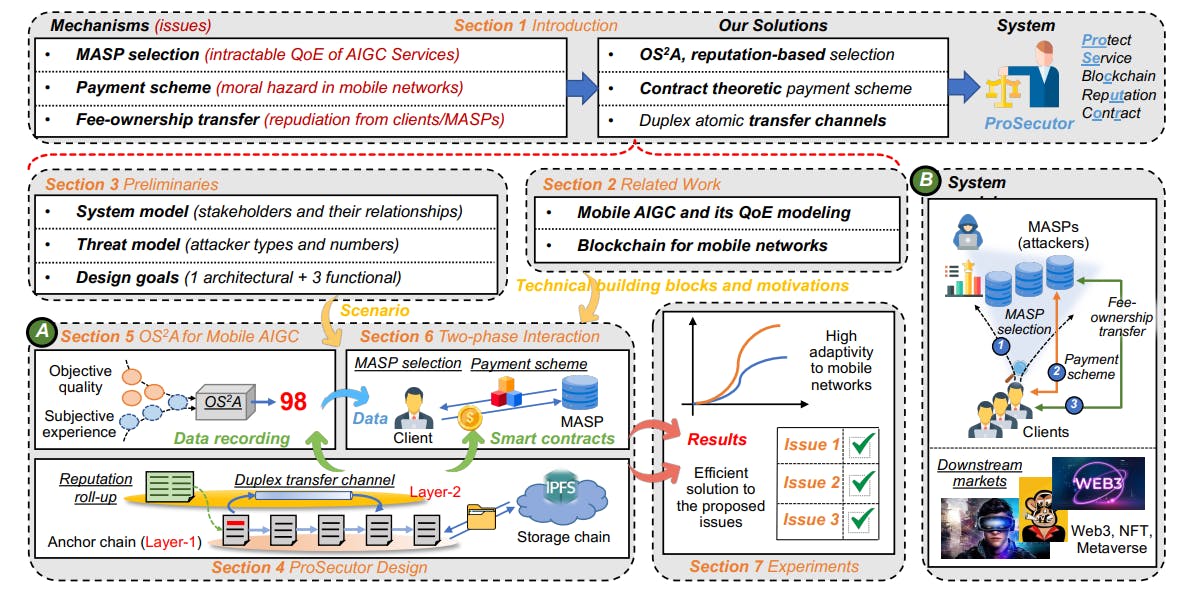Table of Links
1.3 Our Work and Contributions and 1.4 Organization
-
Related Work
-
Prosecutor Design
-
OS2a: Objective Service Assessment for Mobile AIGC
-
OS2A on Prosecutor: Two-Phase Interaction for Mobile AIGC
-
Implementation and Evaluation
7.1 Implementation and Experimental Setup
7.2 Prosecutor Performance Evaluation
1.3 Our Work and Contributions
In this paper, we design the aforementioned mechanisms systematically to protect mobile AIGC. Inspired by Discrete Choice Modeling (DCM) [15], we overcome the obstacles on AIGC service evaluation by presenting a novel framework called Objective-Subjective Service Assessment (OS2A). Particularly, OS2A consists of both objective and subjective components, called OS2AO and OS2AS, respectively. As shown in Fig. 1-Part A, the former measures the quality of the AIGC service process by objective Key Performance Indicators (KPIs), such as service latency. On the other hand, the client’s subjective opinions of the service outcome, i.e., the AIGC outputs, are captured via OS2AS. To support subjectivity and multimodality, we utilize the reputation based on Multi-Weight Subjective Logic (MWSL) [16] to model the OS2AS, allowing clients to express their opinions by customized models and personal preferences. Leveraging OS2A, MASP selection and payment scheme are realized. Firstly, the clients select MASPs according to OS2AS, since higher reputation indicates that the MASPs are more likely to be reliable. Afterward, the contract theory is adopted to optimize the payment scheme, which can maximize clients’ utility while circumventing the moral hazard.
Nonetheless, the proposed mechanisms are vulnerable in practical mobile AIGC. For instance, OS2A is maintained based on the KPI and opinions reported by all clients, which attackers might disrupt. To this end, we present the first mobile AIGC-oriented blockchain, called ProSecutor. Specifically, by roll-up [17] and layer-2 channels [18], ProSecutor builds a two-layer architecture to overcome the resource limitations in mobile AIGC. To defend against OS2A tampering, ProSecutor validates and stores all the historical data in an immutable chained ledger. Moreover, ProSecutor serves as the Turing-complete smart contract engine, with which we implement MASP selection, payment scheme, and atomic fee-ownership transfers. The contribution of this paper can be summarized as follows.
• AIGC-Oriented Blockchain: We propose ProSecutor, the first blockchain system for protecting mobile AIGC. By maintaining immutable records, ProSecutor enables the tamper-proof reputation calculation in public mobile networks. Moreover, it serves as the smart contract engine on which we realize the atomic fee-ownership transfers. Particularly, to facilitate mobile networks, these functions are realized in lightweight manners, i.e., reputation roll-up and transfer channels.
• OS2A Framework: Inspired by DCM, we present OS2A to evaluate the mobile AIGC services. Containing two components, OS2A can evaluate both the objective service process and the subjective service outcome. Moreover, we utilize the MWSL-based reputation scheme to model the subjective component, making OS2A compatible with multimodal AIGC.
• Contract Theory for AIGC: Deploying OS2A in ProSecutor, we realize MASP selection and payment scheme by a two-phase process. Through OS2AS, each client can select the best MASP with the highest reputation. Then, the contract theory is utilized to optimize the payment scheme, protecting the deserved utility of the client against moral hazard.
• Experimental Results: We develop ProSecutor prototype with OS2A framework. Three mechanisms, i.e., reputation-based MASP selection, contract theoretic payment scheme, and atomic transfer, are also developed. Extensive experiments in mobile environments validate the lightweight features of ProSecutor and the effectiveness of the proposed mechanisms.
1.4 Organization
The structure of this paper is illustrated in Fig. 1. Section 2 reviews the existing related works, which not only provides technical building blocks but also states the motivations. Then, we model the mobile AIGC scenario in Section 3. Section 4 demonstrates ProSecutor design, offering a lightweight and secure environment for data recording and mechanism executions. In addition, the atomic feeownership transfer is presented. Section 5 illustrates the design of OS2A framework. Deploying OS2A on ProSecutor, the MASP selection and contract theoretic payment scheme are discussed in Section 6. Section 7 implements the prototype of ProSecutor and analyzes the experimental results. Finally, Section 8 draws the conclusion.
Authors:
(1) Yinqiu Liu, School of Computer Science and Engineering, Nanyang Technological University, Singapore ([email protected]);
(2) Hongyang Du, School of Computer Science and Engineering, Nanyang Technological University, Singapore ([email protected]);
(3) Dusit Niyato, School of Computer Science and Engineering, Nanyang Technological University, Singapore ([email protected]);
(4) Jiawen Kang, School of Automation, Guangdong University of Technology, China ([email protected]);
(5) Zehui Xiong, Pillar of Information Systems Technology and Design, Singapore University of Technology and Design, Singapore ([email protected]);
(6) Abbas Jamalipour, School of Electrical and Information Engineering, University of Sydney, Australia ([email protected]);
(7) Xuemin (Sherman) Shen, Department of Electrical and Computer Engineering, University of Waterloo, Canada ([email protected]).
This paper is


